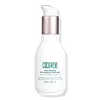What's inside
What's inside
 Key Ingredients
Key Ingredients

No key ingredients
 Benefits
Benefits

 Concerns
Concerns

 Ingredients Side-by-side
Ingredients Side-by-side

Water
Skin ConditioningCetearyl Alcohol
EmollientButylene Glycol
HumectantCetrimonium Chloride
AntimicrobialBis-PCA Dimethicone
Behentrimonium Chloride
PreservativeCetrimonium Methosulfate
AntimicrobialCocos Nucifera Oil
MaskingDisodium PEG-12 Dimethicone Sulfosuccinate
CleansingEthylhexyl Palmitate
EmollientParfum
MaskingLactic Acid
BufferingPersea Gratissima Oil
Skin ConditioningPrunus Armeniaca Kernel Oil
MaskingPunica Granatum Seed Oil
EmollientQuaternium-91
Stearamidopropyl Dimethylamine
EmulsifyingSodium Benzoate
MaskingAminomethyl Propanol
BufferingPotassium Sorbate
PreservativeEthylhexylglycerin
Skin ConditioningGlycerin
HumectantPassiflora Edulis Fruit Extract
Skin ConditioningTetrasodium Glutamate Diacetate
Water, Cetearyl Alcohol, Butylene Glycol, Cetrimonium Chloride, Bis-PCA Dimethicone, Behentrimonium Chloride, Cetrimonium Methosulfate, Cocos Nucifera Oil, Disodium PEG-12 Dimethicone Sulfosuccinate, Ethylhexyl Palmitate, Parfum, Lactic Acid, Persea Gratissima Oil, Prunus Armeniaca Kernel Oil, Punica Granatum Seed Oil, Quaternium-91, Stearamidopropyl Dimethylamine, Sodium Benzoate, Aminomethyl Propanol, Potassium Sorbate, Ethylhexylglycerin, Glycerin, Passiflora Edulis Fruit Extract, Tetrasodium Glutamate Diacetate
Water
Skin ConditioningAmodimethicone
Butylene Glycol
HumectantBetaine
HumectantBis-PCA Dimethicone
Sorbitan Laurate
EmulsifyingCetrimonium Chloride
AntimicrobialPanthenol
Skin ConditioningTrideceth-12
EmulsifyingGlycerin
HumectantPEG-40 Hydrogenated Castor Oil
EmulsifyingSodium Benzoate
MaskingHydrolyzed Pea Protein Pg-Propyl Silanetriol
Skin ConditioningAminomethyl Propanol
BufferingAloe Barbadensis Leaf Juice Powder
Skin ConditioningDisodium PEG-12 Dimethicone Sulfosuccinate
CleansingPotassium Sorbate
PreservativeCitric Acid
BufferingPolyglyceryl-4 Laurate
EmulsifyingAlcohol
AntimicrobialHelianthus Annuus Seed Extract
Skin ConditioningDilauryl Citrate
EmollientPhenoxyethanol
PreservativeAvena Strigosa Seed Extract
Skin ConditioningLecithin
EmollientWater, Amodimethicone, Butylene Glycol, Betaine, Bis-PCA Dimethicone, Sorbitan Laurate, Cetrimonium Chloride, Panthenol, Trideceth-12, Glycerin, PEG-40 Hydrogenated Castor Oil, Sodium Benzoate, Hydrolyzed Pea Protein Pg-Propyl Silanetriol, Aminomethyl Propanol, Aloe Barbadensis Leaf Juice Powder, Disodium PEG-12 Dimethicone Sulfosuccinate, Potassium Sorbate, Citric Acid, Polyglyceryl-4 Laurate, Alcohol, Helianthus Annuus Seed Extract, Dilauryl Citrate, Phenoxyethanol, Avena Strigosa Seed Extract, Lecithin
 Reviews
Reviews

Ingredients Explained
These ingredients are found in both products.
Ingredients higher up in an ingredient list are typically present in a larger amount.
Aminomethyl Propanol is used to adjust the pH of products. It is also used as a base to create other organic compounds. Having a balanced pH is important for protecting your skin.
Aminomethyl propanol is safe to use in cosmetics up to 1%. It is soluble in water.
Bis-PCA Dimethicone is a type of silicone.
Butylene Glycol (or BG) is used within cosmetic products for a few different reasons:
Overall, Butylene Glycol is a safe and well-rounded ingredient that works well with other ingredients.
Though this ingredient works well with most skin types, some people with sensitive skin may experience a reaction such as allergic rashes, closed comedones, or itchiness.
Learn more about Butylene GlycolThis ingredient is a preservative, antimicrobial, and emulsifier. It is often used in cosmetics for its ability to cleanse, condition, and reduce static.
Cetrimonium chloride is a quaternary ammonium salt, meaning it has a water-soluble structure.
Disodium PEG-12 Dimethicone Sulfosuccinate is a type of silicone.
Glycerin is already naturally found in your skin. It helps moisturize and protect your skin.
A study from 2016 found glycerin to be more effective as a humectant than AHAs and hyaluronic acid.
As a humectant, it helps the skin stay hydrated by pulling moisture to your skin. The low molecular weight of glycerin allows it to pull moisture into the deeper layers of your skin.
Hydrated skin improves your skin barrier; Your skin barrier helps protect against irritants and bacteria.
Glycerin has also been found to have antimicrobial and antiviral properties. Due to these properties, glycerin is often used in wound and burn treatments.
In cosmetics, glycerin is usually derived from plants such as soybean or palm. However, it can also be sourced from animals, such as tallow or animal fat.
This ingredient is organic, colorless, odorless, and non-toxic.
Glycerin is the name for this ingredient in American English. British English uses Glycerol/Glycerine.
Learn more about GlycerinPotassium Sorbate is a preservative used to prevent yeast and mold in products. It is commonly found in both cosmetic and food products.
This ingredient comes from potassium salt derived from sorbic acid. Sorbic acid is a natural antibiotic and effective against fungus.
Both potassium sorbate and sorbic acid can be found in baked goods, cheeses, dried meats, dried fruit, ice cream, pickles, wine, yogurt, and more.
You'll often find this ingredient used with other preservatives.
Learn more about Potassium SorbateSodium Benzoate is a preservative. It's used in both cosmetic and food products to inhibit the growth of mold and bacteria. It is typically produced synthetically.
Both the US FDA and EU Health Committee have approved the use of sodium benzoate. In the US, levels of 0.1% (of the total product) are allowed.
Sodium benzoate works as a preservative by inhibiting the growth of bacteria inside of cells. It prevents the cell from fermenting a type of sugar using an enzyme called phosphofructokinase.
It is the salt of benzoic acid. Foods containing sodium benzoate include soda, salad dressings, condiments, fruit juices, wines, and snack foods.
Studies for using ascorbic acid and sodium benzoate in cosmetics are lacking, especially in skincare routines with multiple steps.
We always recommend speaking with a professional, such as a dermatologist, if you have any concerns.
Learn more about Sodium BenzoateWater. It's the most common cosmetic ingredient of all. You'll usually see it at the top of ingredient lists, meaning that it makes up the largest part of the product.
So why is it so popular? Water most often acts as a solvent - this means that it helps dissolve other ingredients into the formulation.
You'll also recognize water as that liquid we all need to stay alive. If you see this, drink a glass of water. Stay hydrated!
Learn more about Water